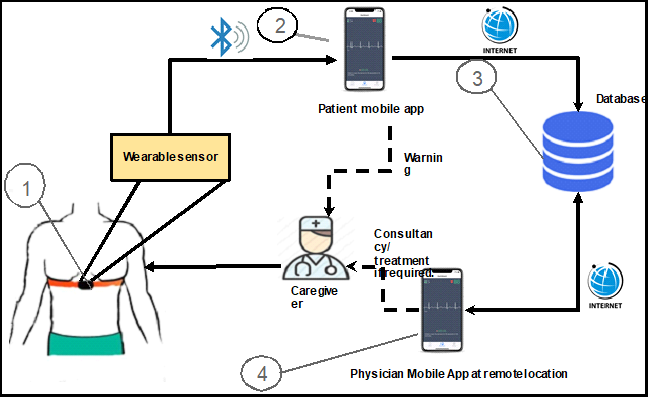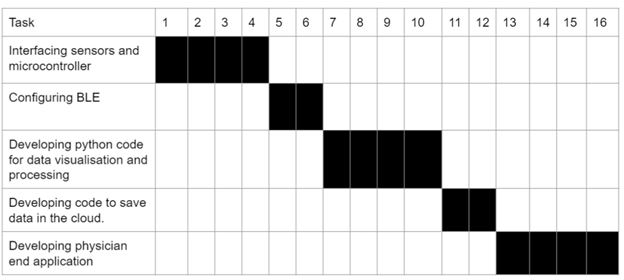Information Technology Assignment: IoT Applications in Healthcare And Patient Management
Question
Task:
Prepare an information technology assignment presenting a dissertation on the topic “IoT applications in healthcare and patient management”.
Answer
1. Project Summary
The present information technology assignment talks about Internet of things (IoT) which is a technology wherein all the regular or specialized devices are connected to the internet so that they can interact collaborate and exchange data with each other. IoT finds its application in various fields like IoT in everyday life, healthcare, industrial automation, and disaster management.
In today’s complex healthcare environment, the demands on clinicians are immense. Before the IoT, the only way for interaction between the patient and the physician was limited to visits, telecommunication, or text communication. There was no way the physician a continuously monitor the patient remotely. The IoT in healthcare and patient management can help clinicians make informed decisions, reduce variation in care delivery, and lower costs. The IoT in healthcare and patient management will simplify the life of a clinician, remove complexity as a barrier to faster decision making, reduce variability in care delivery, integrate emerging technology with the hospital’s IT system and Electronic medical record (EMR).
2. Research Area
In the early 2000, scholars from all over the world gradually started their work in smart health using IoT. Li et al. [1] carried out the study to establish a relationship between the acceptance of smart wearable devices and elderly people. They also pointed out the factors like economic status, education that impacts the acceptance of the devices. Akbulut et al. [2] designed a wearable device to monitor cardiovascular disease and the long term impact. They also explored emotional dynamics that play a vital role in improving the accuracy of assessment of the risk. Grym et al. [3] designed a smart wristband to monitor the user during the pregnancy and one month after pregnancy. They explored the idea of home monitoring using IoT thus proving home monitoring becomes an important application of IoT in smart healthcare systems. Dawadi et al proposed a clinical assessment of the daily resident’s behavior using clinical scores. They used smart sensors and a statistical features-based learning model to predict the clinical scores. Zhang et al. [4] explored the impact of data fusion algorithm and routing technology in the medical IoT and thus monitoring of the medical data in the internet of things. They designed an intelligent health management data fusion system that is fast and reliable. Hossain et al. [5] designed an industrial IoT healthcare system that can acquire data from the patient using sensors and send these data to the cloud. These data then can be used by the healthcare profession and decisions can be made thus enabling the tele-health care system. Farahani et al. [6] proposed the IoT-based healthcare system architecture. They shifted the healthcare structure from clinic-centric to patient-centric. They also discussed the promises and challenges of IoT in healthcare.
Istepenian et al. [7] developed a mobile platform m-IoT to monitor the glucose level in the blood for hypoglycemia management. Castillejo et al. [8] proposed an activity recognition system. They used smart sensors and an application that can track the activities of the user. Kelati et al. [9] designed a remote monitoring system using IoT. They integrated various sensors that acquire various biosignal and from that signal, various vital parameters are calculated. Electrocardiogram (ECG) and electromyography signals are acquired using wearable sensors. Pham et al. [10] proposed cloud-based home healthcare services. The system includes a smart home, a wearable unit, private cloud, and a robot assistant that provides human contextual information and monitors the vital signals. Lu et al. [11] reviewed all the applications of smartwatch-based IoT applications in the field of healthcare. Shahamabadi et al. [12] proposed a framework to provide healthcare services to elderly patients. The author designed an innovative architecture that is modular for automation, security, and communication for ambient assisted living.
At present, there is much research going on using IoT applications in the field of healthcare. These applications include IoT for patients, IoT for physicians, IoT for hospitals, and Iot for insurance companies. The specific applications can be glucose monitoring systems, activity trackers during cancer, heart monitoring, alarm system in hospitals, remote monitoring, etc.
3. Expected Practical Elements
An IoT application in healthcare generally has four elements.
- A wearable sensor is worn by the patient.
- A mobile application that receives data from the sensors.
- A cloud where all the data is stored.
- Software at the physician to analyze the data.
The architecture of the system is shown in figure 1.

Figure 1: Architecture of the system
A wearable sensor is used by the patient [1]. These sensors acquire the data from the patient. These data can be ECG, EMG and the raw data are transmitted to the mobile phone over Bluetooth low energy (BLE) [2]. These data are received by application in the mobile phone. The application calculates various parameters from these signals and if required alerts the patient. The application sends the data to the cloud over the internet [3]. These personal data needs to protect over the internet. So, various precautions are taken to provide safety to the data. The physician can access the data of the patient from any remote location and can monitor the patient on the go. If the physician finds any abnormalities in the patient data then he can consult the patient to take necessary precautions or treatment. Thus this system can be used to monitor the patient, collect the information of the patient, diagnose the disease and alert the patient if required.
4. Required Resources
For building IoT based healthcare system, we will require software as well as hardware resources.
- Hardware
Wearable Sensors: A wearable sensor will be used to acquire the data from the patient. These sensors will acquire the data like ECG, PPG and will send the data to the microcontroller via UART.
Microcontroller: The microcontroller uses the analog to the digital controller to convert the data into digital form.
Bluetooth Low Energy module (BLE): BLE is used to transmit the data to the mobile application.
- Software
Arduino: Arduino IDE will be used to program the microcontroller for data acquisition and transmitting over BLE.
Python: Python programming language will be used for feature extraction, application building, for sending and receiving data over the internet.
- Cloud Processing
Cloud Processing has three distinct components: storage, analytics, and visualization. The system is designed for the long-term storage of patient’s biomedical information as well as assisting health professionals with diagnostic information. Cloud-based medical data storage and the upfront challenges have been extensively addressed in the literature. Analytics that use the sensor data along with e-Health records that are becoming prevalent can help with diagnoses and prognoses for a number of health conditions and diseases. Additionally, Visualization is a key requirement for any such system because it is impractical to ask physicians to pore over the voluminous data or analyses from wearable sensors. Visualization methods that make the data and analyses accessible to them in a readily digestible format are essential if the wearable sensors are to impact clinical practice.
5. Prerequisite
For building IoT-based healthcare applications, the prerequisite is as follows.
- Embedded language
Embedded language is used to interface the microcontroller and sensors. Embedded C programming language is used for this purpose. - Configuring BLE
For sending data from the BLE module to the mobile app, the BLE needs to be configured. - Scripting language
To do data analysis and designing the graphical user interface, the scripting language is used. We are using python as a sccripting language
6. Project Plan

References
1. Li J, Ma Q, Chan AH, Man S. Health monitoring through wearable technologies for older adults: smart wearables acceptance model. Appl Ergon. 2019;75:162–9.
2. Akbulut FP, Akan A. A smart wearable system for short-term cardiovascular risk assessment with emotional dynamics. Measurement. 2018;128:237–46.
3. Grym K, Niela-Vilén H, Ekholm E, Hamari L, Azimi I, Rahmani A, Liljeberg P, Löyttyniemi E, Axelin A. Feasibility of smart wristbands for continuous monitoring during pregnancy and one month after birth. BMC Pregnancy Childbirth. 2019;19(1):34.
4. Zhang W, Yang J, Su H, Kumar M, Mao Y. Medical data fusion algorithm based on internet of things. Pers Ubiquit Comput. 2018;22(5–6):895–902.
5. Hossain MS, Muhammad G. Cloud-assisted industrial internet of things (iiot)–enabled framework for health monitoring. Comput Netw. 2016;101:192–202.
6. Farahani B, Firouzi F, Chang V, Badaroglu M, Constant N, Mankodiya K. Towards fog-driven IoT eHealth: promises and challenges of IoT in medicine and healthcare. Futur Gener Comput Syst. 2018;78:659–76.
7. R. S. H. Istepanian, D. Castiglia, and J. W. Gregory, “Mobile health (m-Health) for diabetes management,” information technology assignment British Journal of Healthcare Management, vol. 23, no. 3, pp. 102–108, 2017.
8. P. Castillejo, J.-F. Martinez, J. Rodriguez-Molina, and A. Cuerva, “Integration of wearable devices in a wireless sensor network for an E-health application,” IEEE Wireless Communications, vol. 20, no. 4, pp. 38–49, 2013.
9. A. Kelati, “Biosignal monitoring platform using Wearable IoT,” in Proceedings of the 22nd Conference of Open Innovations Association FRUCT, pp. 9–13, Petrozavodsk, Russia, May 2018.
10. Pham M, Mengistu Y, Do H, Sheng W. Delivering home healthcare through a cloud-based smart home environment (CoSHE). Futur Gener Comput Syst. 2018;81:129–40.
11. Lu T-C, Fu C-M, Ma MH-M, Fang C-C, Turner AM. Healthcare applications of smartwatches. Appl Clin Inform. 2016;7(03):850–69.
12. M. S. Shahamabadi, “A network mobility solution based on 6LoWPAN hospital wireless sensor network (NEMO-HWSN),” in Proceedings of the 2013 Seventh International Conference on Innovative Mobile and Internet Services in Ubiquitous Computing, pp. 433–438, Taichung, Taiwan, July 2013.












